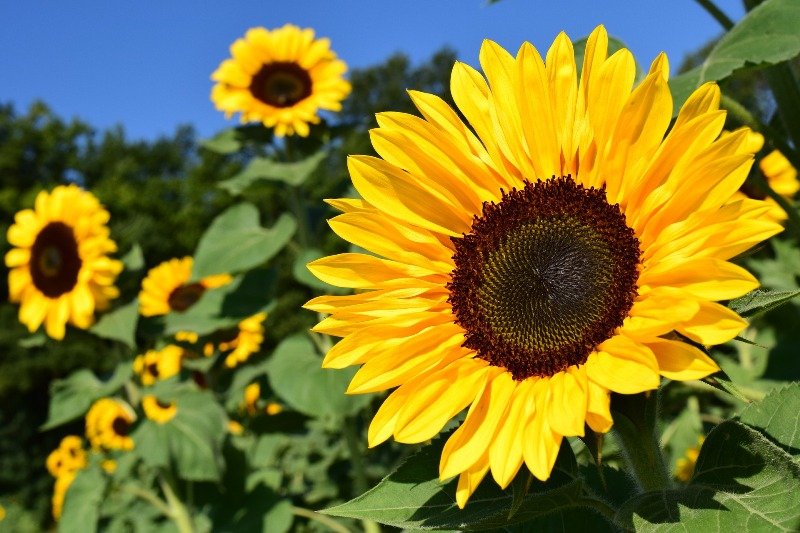
The Complete and Only Sunflower Care Guide You’ll Ever Need
As we round the corner straight into summer, we’re also getting closer to sunflower season.
You’ll notice that, in the United States, there are both oil-type sunflower seeds and non-oil sunflower seeds, both of which yield beautiful flowers all summer long.
Seeing as sunflowers most commonly bloom during the summer with the middle of summer being their peak season, it’s important to know how to care for this unique flower during the warmer months.
From choosing which types of sunflower seeds to plant to learning how to best grow the flowers indoors, we’ve got your complete sunflower care guide ready to go. Where do sunflowers grow and what helps them thrive? We’ve got all of the answers for you.
When Do Sunflowers Bloom?

Before you’re able to learn about how to care for sunflowers, it’s important to understand a bit of their background and where and when they thrive. So, when do sunflowers bloom?
Sunflower season goes from about June to September and generally lasts no more than about 90 days. The middle of the summer season is also peak season for sunflowers and their growth.
This is likely why the bright, vibrant flowers are associated with summer. And, the reason is due to the fact that the flowers, well, they love the sun. They’re known for turning their “heads” to follow the sun throughout the day.
So, it makes sense that they bloom and thrive during the summer when there is the most direct sunlight, at least in the northern hemisphere. However, this can vary a little depending on whether or not you’re planting an annual or perennial.
Most sunflowers you see are Helianthus annuus, which are hybrid varieties of a common sunflower. These can look yellow, orange, or even red in color. And, this variety of sunflower takes less time to fully mature.
Other varieties of sunflowers include perennials such as the beach sunflower or willowleaf sunflower. The latter blooms a bit later, reaching full maturity from mid to late fall.
Where Can You Grow Sunflowers?
As mentioned, there are different types of sunflowers with some types falling into either the annual or perennial categories. Annual sunflowers are often larger, reaching up to 120 inches in height. And, they grow the best in Mediterranean climates.
The Mexican sunflower, however, which is a type of common annual sunflower, only grows up to about 72 inches tall and thrives best in coastal climates. In understanding where sunflowers grow best, it’s helpful to look at the USDA Plant Hardiness Zone Map.
While sunflowers thrive in environments where there is plenty of sun, certain types will most certainly grow better in certain zones where the soil is more fit for that type of sunflower.
The willowleaf sunflower, for example, grows best in USDA zones 5 through 9. Those zones stretch from about the lower half of the Northern United States all the way down to the Mexican border and southern coasts.
So, regardless of the time of sunflowers you have, you can pretty much bet that they’ll grow all across the United States as long as you’re caring for them correctly. They do best, however, in slightly acidic soils (think of a pH between about 6.0 to 7.5).
Following the Life Cycle of a Sunflower

As long as sunflowers have the right kind of soil and plenty of sunlight, chances are they’ll thrive in most environments across the country.
Growing a sunflower indoors is possible, but before you’re able to do so, you need to understand the life cycle of the flower.
The germination phase is the initial phase in which you plant the sunflower seeds. Germination refers to the process of the roots forming and taking hold in the soil. For sunflowers, the germination phase can last up to about eight days.
You’ll notice a small little shoot sticking out of the soil during this phase as the flower begins to grow and search for the sun. Plant your seeds around April or May to ensure that the soil is able to reach 70 to 85 degrees Fahrenheit for germination.
The next phase is the vegetative phase. This is when the plant begins to form leaves. Expect this to take up to a month from when you planted the seed. So, in most sunflowers, this would occur in May or June.
During the reproductive phase, buds will begin to form. From beginning to end, this lasts about thirty days. At the end of this phase, you’ll see the beautiful, standard image of a large, full, yellow sunflower.
However, the life cycle doesn’t stop there! The blooming phase lasts for about 20 days in most varieties of sunflowers. This means you can cut the flower and place it in a vase or even make a beautiful sunflower bouquet to enjoy for a couple of weeks.
How to Plant Sunflowers
As mentioned, most types of sunflowers thrive in nearly every type of soil but will especially thrive in soil that is nutrient-rich. Planting your sunflower seeds after mid-spring ensures that the soil temperature will be prime which is at least 60 degrees.
What about the seeds themselves? You’ll want to stick them softly into the soil no more than about an inch deep. If you’re planting more than one seed at a time, spread them out about six inches apart.
If you are planning on growing taller sunflowers, you can spread the seeds out to about twelve inches apart. This will ensure that each plant has room to grow and flourish.
Now, if you’re only planting sunflowers for your personal use, you might not need to think about stagger planting. However, if you’d like to sell your sunflowers or simply have a full garden well throughout the entire summer, consider researching stagger planting.
Staggered planting, or sometimes called succession planting, is when you sow new rows of plants every two weeks or so. If you want your garden to be consistently full of fully bloomed sunflowers all summer long, it’s a good idea.
Beginning in the spring, stagger plant new rows of sunflowers about every two weeks until about mid-summer.
After this, the last seeds you plant should bloom before the first frost, ensuring your garden is bright and vibrant well throughout the beginning of fall.
What to Know About Sunflower Care

Sunflower care is pretty easy, actually, as they are low-maintenance plants.
Once the plant has grown up past the soil line, you can begin to water your sunflowers right up around the roots. You’ll want to water the soil out until you get about four inches from where the roots extend.
After your sunflower has grown a bit and begins to bloom, the key to caring for sunflowers lies in watering deeply to encourage the flower to take deep roots. This means that, while you only have to water it once a week, it will need a lot of water.
If you don’t live in an area where you get lots of rain during the summer or if the heat causes the soil to dry up, water each sunflower plant with a few gallons of water once a week. Ensure that you’re letting the water sink deep down into the roots.
There are different methods for watering deeply, but you can turn a hose on at about a fourth of its capacity and let it drip down into the soil slowly for four to six hours.
Aside from that, sunflower care is simple. If you’re planning on growing a taller variety of the colorful flower, provide the stems with some support to prevent them from toppling over.
Time to cut the flowers down for use in a bouquet or simply to share with a friend or family member? Experts suggest cutting them down in the morning before the heat gets to the plant.
Place the cut stem into the water and keep it in a room-temperature environment where it can still receive lots of sunlight. If you do this properly, a cut sunflower should last for about a week in a vase.
Caring for Sunflowers Year After Year
Sunflower care is so simple that you’ll likely fall in love with the ease that comes with the beautiful flower. And, there are so many unique varieties to choose from that you can design a new sunflower garden each summer.
Perennial sunflowers will come back each year, meaning you don’t have to necessarily worry about the pre-planning and planting that comes along with annual sunflowers. However, these take longer to mature in the first place.
While you’re waiting for the sunflowers to bloom, you can attend to other areas of your garden or engage in home improvement projects that will complement the look of your sunflowers once they’re in full bloom.
For ideas, tips, and more, check out our Home and Garden section to find numerous helpful articles to guide you.




